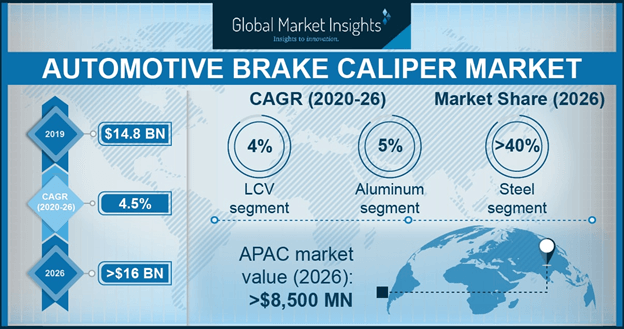APAC automotive brake caliper market to garner substantial remuneration by 2024, technologically advanced products to swamp the global industry landscape
Publisher : Fractovia | Published Date : 2018-05-08Request Sample
Driven by the swiftly proliferating automotive industry across the globe, automotive brake caliper market has been gaining commendable traction of late. The automotive sector has been swamped with exceptional innovations that have invariably favored this business space. Aided by a slew of stringent environmental policies, this vertical has been the recipient of commendable technological progression. In consequence, this has had a game-changing impact on automotive brake caliper industry trends.
U.S. Automotive Brake Caliper Market, By Vehicle, 2016 & 2024, (Million Units)

An instance justifying the aforementioned statement is that of ACDelco recently unveiling a brand-new aftermarket brake caliper in aluminum and cast iron with no core charge. The latest caliper comes with high-quality bleeder screws and pistons and is pre-lubricated for seamless operation. The cast iron parts are said to be zinc-plated which assist in corrosion protection. Apparently, ACDelco’s new offering demonstrates the persistent efforts of automotive brake caliper market participants to enhance and optimize the performance of modern age braking systems.
A marked increase in vehicle production and the rising consumer expenditure has resulted in a significant demand for passenger carrying vehicles across the globe. In 2017 for instance, the worldwide PCV sales stood at about 73.46 million units which was a humongous 1.08 million units more than the previous year. In fact, as per a research report by Global Market Insights, Inc., the overall automotive brake caliper industry share from PCVs is anticipated to grow by 3% over 2017-2024. Although PCVs have garnered immense admiration, light commercial vehicles have found increased preference lately, particularly in the developing nations. Apparently, the shifting trend toward deploying disc brakes in light commercial vehicles has drastically lowered the manufacturing expenses of the product. Consequentially, this has augmented the automotive brake caliper market outlook in the recent times.
Meanwhile, it would be prudent to mention that highly-efficient and cutting-edge technologies have been making rapid inroads in the overall automotive brake caliper industry of late. To cite an instance of the same, in January 2018, Bugatti had declared that it has created the world’s first fully-functional 3D printed brake caliper. Incidentally, the latest brake caliper has been made out of a titanium alloy which delivers superior performance than aluminum, claims the France based automotive brake caliper market major. It takes around 45 hours to print a single brake caliper with the finished product weighing around 6.4 pounds, lighter than the aluminum alloy which currently weighs approximately 10.8 pounds. Moreover, a total force of 275 pounds can be exerted on a square millimeter of the titanium component without rupturing the material. Thus, it goes without saying that the launch of such efficient and innovative calipers would substantially reduce the overall vehicle weight over the forthcoming years.
Speaking of the regional growth prospects of automotive brake caliper market, the Asia Pacific territory has been one of the most fruitful in terms of expanding the sphere of influence of this business space. The rise of the middle-class population with the increasing disposable incomes have made consumers more inclined toward leading a luxurious lifestyle. This has, in consequence, led to a spurt in the sales of automobiles across emerging economies such as India, China, Japan, and South Korea. Apparently, these developing nations are forecast to contribute majorly toward the Asia Pacific automotive brake caliper industry which is set to grow at a CAGR of 3% over 2017-2024.
With a massive escalation in research & development programs across the automotive sector, it is quite apparent that the global automotive brake caliper industry trends would witness a paradigm shift of sorts in the ensuing years. Moreover, prominent automakers have been focusing on introducing automated technologies to enhance the overall mobility of vehicles – a factor that would certainly impact the automotive brake caliper market landscape. The growing concern pertaining to air pollution has compelled the market participants to ramp up their efforts to reduce the caliper mass, as it would lower the carbon emission and particulate matter released from vehicles. This would subsequently have a tremendous influence on the automotive brake caliper industry share which is expected to surpass USD 25 billion by 2024, as per reliable reports.